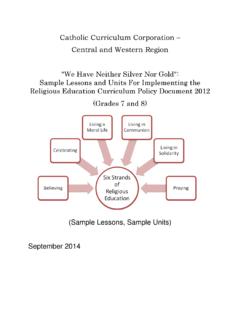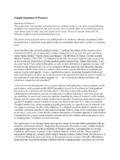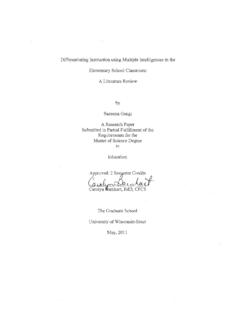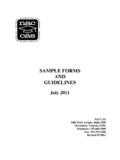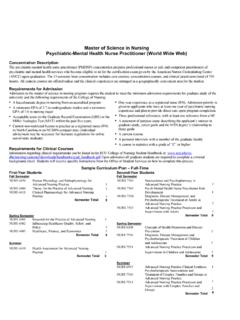Transcription of A Framework for Kindergarten In Catholic Schools In God’s ...
1 A Framework for Kindergarten In Catholic Schools In God s Image - A Primary Foundation Catholic Curriculum Corporation Central and Western Regions October 2007 2 Table of Contents Forward and Acknowledgements 4 Section 1 Background for Teachers 6 Physical, Intellectual, Social, Emotional, & Spiritual Development 8 Using A Framework for Kindergarten in Catholic Schools 9 Components of In God s Image Program 10 Guiding Principles for a Catholic Classroom 11 Section 2 Considerations for Developmentally Appropriate Practices for JK - SK 13 Section 3 Entry to school 14 Guiding Principles for Entry to school 15 Essential Components of an Entry to school Process 16 Effective Planning for Children with Special Needs 17 Section 4 Building a Welcoming Learning Environment 18 Organizing the Classroom 19 Setting the Scene 20 Floor Plans 21 Using Activity Centres 22 Early Childhood Environment Rating Scale 23 Which Centres Do We Need?
2 What Do We Do There? 23 Centres in the Classroom 24 Section 5 Program Planning Using In God s Image 30 Yearly Overview 31 Monthly Themes 33 On-Going Themes throughout the Year 66 Themes Driven by Student Interest 70 Section 6 Teaching Literacy and Numeracy 73 Teaching Literacy in Junior and Senior Kindergarten 73 Reading Instruction 74 Writing Instruction 75 The Literacy Process 76 Numeracy Instruction: Understanding the Early Math Learner 77 3 Section 7 Assessment and Evaluation 80 Principles of Assessment and Evaluation in Junior & Senior Kindergarten 81 Balanced Assessment and Evaluation 82 Methods of Assessment 83 Web Based Teaching Tool (WBTT)
3 84 Communicating with Parents 85 Valuable Resources for Assessment and Evaluation in Kindergarten 86 Section 8 Essentials for Teachers 87 Section 9 Resources 90 Suggested Read Alouds 90 Big Books for Shared Reading 100 Additional Resources for Teachers 102 Section 10 Community Connections 104 Early Years Centres 104 Local Contact Numbers Template 105 Section 11 Appendices 106 Appendix 1: Long Range Planning Templates & Sample Plans 106 Appendix 2: Blank Planning Templates 2007-2008 117 Appendix 3: Catholic Curriculum Maps Core Map for Kindergarten 128 4 A Framework for Kindergarten in Catholic Schools In God s Image - A Primary Foundation Forward Our Mission and purpose The Catholic Curriculum Corporation is a consortium of seventeen Catholic school boards across central and western Ontario.
4 As an important partner in Catholic education, we recognize that Catholic education exists to provide a holistic formation of people as living witnesses of faith. We demonstrate our mission when we engage with, and support, our member boards in sustained, substantive school improvement and student growth that is reflective of a Catholic professional learning community. Mission Statement Building and sustaining the Catholic capacity of educators through the development and provision of high quality Catholic curriculum, resources, support and professional development. Message from the Executive Director On behalf of the Catholic Curriculum Corporation, I would like to invite educators to review and use this rich Kindergarten resource. The writers have made every effort to ensure it aligns with current Ministry documents, while examining it with the lens of the Catholic learner.
5 Based on the In God s Image Religion program, A Framework for Kindergarten in Catholic Schools provides a wealth of information, offering suggestions in the areas of developmental practices, entry to school , building a welcoming learning environment, assessment & evaluation and more. The planning examples and templates provide a rich reference document for teachers. The Catholic Curriculum Corporation would like to thank Carol Bryden and the St. Clair CDSB writers, as well as the reviewers from Halton CDSB. Certainly, their exemplary work has brought to reality the development of this faith-filled Kindergarten resource. Blake, Executive Director 5 Acknowledgements Project Lead Carol Bryden, St. Clair CDSB (retired) Writers Carrie Cicchelli, St. Clair CDSB Mary Jo Cocarell, St.
6 Clair CDSB Carmen Gagnier, St. Clair CDSB Dianne Lloyd, St. Clair CDSB Reviewers Andrea Bishop, Halton CDSB Anne McNeill, Halton CDSB Christine Spotswood, Halton CDSB Fran Craig, Curriculum Manager, CCC The authors would like to thank the following boards for generously sharing their Kindergarten resource materials: The Durham Catholic District school Board The Huron Perth Catholic District school Board The Niagara Catholic District school Board The Waterloo Catholic District school Board The Toronto Catholic District school Board The St. Clair Catholic District school Board 6 Section 1 Background for Teachers CURRICULUM IN Catholic Schools Catholic Schools have the unique educational purpose of presenting a Catholic world view to their students. A Catholic world view is a way of looking at the world through a Catholic Church lens.
7 This world view is derived from Catholic Church teachings, scripture and Catholic Church traditions. These teachings, scripture and traditions form the basis of what is taught in Catholic Schools . A Catholic world view is infused into Catholic Curriculum when writers combine Ontario Catholic school Graduate Expectations and Ontario Ministry of Education expectations for a specific subject to create resources for teachers to use in Catholic classrooms. The perspective of the Catholic Church permeates all of the content that teachers present in each subject area. Teachers make the students aware of the Church s position during lessons, discussions, and other curriculum activities. The integration of our faith into all aspects of our curriculum, demonstrates the oneness of ourselves, our world and God s vision for us.
8 While following Ministry s curriculum expectations for Kindergarten , Catholic curriculum is developed from the following foundational elements: Scripture and Catholic Church Teaching, Curriculum Support for Catholic Schools , The Ontario Catholic school Graduate Expectations Education for All Educating the Soul These resources embody and proclaim the philosophy and distinctiveness of Catholic curriculum. In our classrooms, both teachers and students need to be able to articulate a Catholic world view. The challenge for writers of Catholic curriculum is to ensure that the Catholic world view is explicitly evident in their writing if they are to produce support resources that teachers can use with confidence that they reflect Catholic Church teachings. Writing Catholic Curriculum: A Course for Writers of Catholic Curriculum CCC, 2006, p 7-8 7 The Catholic Curriculum Corporation recognizes the need for a Framework to assist Junior and Senior Kindergarten teachers in preparing a program that is developmentally appropriate, incorporates the expectations from The Ontario Kindergarten Program 2006 - Revised and recognizes the potential for the spiritual growth of the child.
9 In 1991, the Conference of Catholic Bishops published the Kindergarten program In God s Image. This program is part of the Born in the Spirit series for students in Kindergarten through Grade 8. A Framework for Kindergarten in Catholic Schools is an attempt to highlight the appropriateness and continued currency of the In God s Image for four and five year old students, and to recognize and highlight the connections to The Ontario Kindergarten Program 2006 - Revised. This Framework demonstrates how the activities found In God s Image are relevant and can be used to meet many of the expectations in the Ontario Kindergarten Program 2006 - Revised. The first years of school are critical in preparing young students to enjoy their school years and to become life long learners. The committee encourages all Kindergarten teachers to reference the Best Start Expert Panel on Early Learning 2006 Early Learning for Every Child Today - A Framework for Ontario Childhood Settings.
10 This report contains valuable information for every Kindergarten teacher. Of particular value is the Continuum of Development which describes the five domains of human development social, emotional, communication and language literacy, cognition and physical. Essential skills within each domain are listed. A list of indicators of normal development followed by appropriate interactions describes each of these skills. This continuum is arranged to describe the development of infants, toddlers, preschool/ Kindergarten and young school aged children. This report can provide valuable information to the teacher in planning and delivering a well rounded program for students. Early Learning for Every Child Today - A Framework for Ontario Childhood Settings can be accessed at: 8 Physical, Intellectual, Social, Emotional and Spiritual Development Children develop in several domains as they grow and mature.


